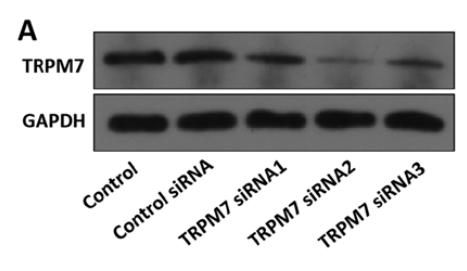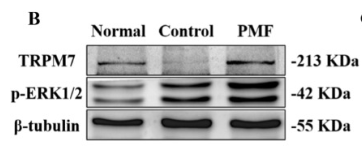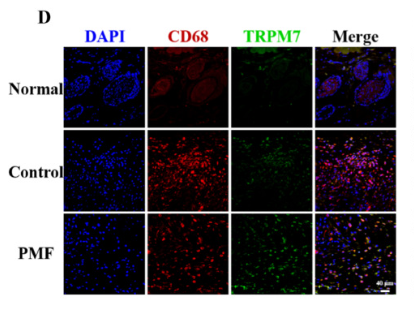TRPM7 Antibody - #DF7513
| Product: | TRPM7 Antibody |
| Catalog: | DF7513 |
| Description: | Rabbit polyclonal antibody to TRPM7 |
| Application: | WB IHC IF/ICC |
| Cited expt.: | WB, IF/ICC |
| Reactivity: | Human, Mouse, Rat |
| Prediction: | Pig, Bovine, Horse, Sheep, Rabbit, Dog |
| Mol.Wt.: | 213 KD; 213kD(Calculated). |
| Uniprot: | Q96QT4 |
| RRID: | AB_2841012 |
Product Info
*The optimal dilutions should be determined by the end user. For optimal experimental results, antibody reuse is not recommended.
*Tips:
WB: For western blot detection of denatured protein samples. IHC: For immunohistochemical detection of paraffin sections (IHC-p) or frozen sections (IHC-f) of tissue samples. IF/ICC: For immunofluorescence detection of cell samples. ELISA(peptide): For ELISA detection of antigenic peptide.
Cite Format: Affinity Biosciences Cat# DF7513, RRID:AB_2841012.
Fold/Unfold
ALSPDC; CHAK; CHAK1; Channel kinase 1; Channel-kinase 1; Long transient receptor potential channel 7; LTrpC-7; LTrpC7; Transient receptor potential cation channel subfamily M member 7; TRP PLIK; TRPM7; TRPM7_HUMAN;
Immunogens
A synthesized peptide derived from human TRPM7, corresponding to a region within C-terminal amino acids.
- Q96QT4 TRPM7_HUMAN:
- Protein BLAST With
- NCBI/
- ExPASy/
- Uniprot
MSQKSWIESTLTKRECVYIIPSSKDPHRCLPGCQICQQLVRCFCGRLVKQHACFTASLAMKYSDVKLGDHFNQAIEEWSVEKHTEQSPTDAYGVINFQGGSHSYRAKYVRLSYDTKPEVILQLLLKEWQMELPKLVISVHGGMQKFELHPRIKQLLGKGLIKAAVTTGAWILTGGVNTGVAKHVGDALKEHASRSSRKICTIGIAPWGVIENRNDLVGRDVVAPYQTLLNPLSKLNVLNNLHSHFILVDDGTVGKYGAEVRLRRELEKTINQQRIHARIGQGVPVVALIFEGGPNVILTVLEYLQESPPVPVVVCEGTGRAADLLAYIHKQTEEGGNLPDAAEPDIISTIKKTFNFGQNEALHLFQTLMECMKRKELITVFHIGSDEHQDIDVAILTALLKGTNASAFDQLILTLAWDRVDIAKNHVFVYGQQWLVGSLEQAMLDALVMDRVAFVKLLIENGVSMHKFLTIPRLEELYNTKQGPTNPMLFHLVRDVKQGNLPPGYKITLIDIGLVIEYLMGGTYRCTYTRKRFRLIYNSLGGNNRRSGRNTSSSTPQLRKSHESFGNRADKKEKMRHNHFIKTAQPYRPKIDTVMEEGKKKRTKDEIVDIDDPETKRFPYPLNELLIWACLMKRQVMARFLWQHGEESMAKALVACKIYRSMAYEAKQSDLVDDTSEELKQYSNDFGQLAVELLEQSFRQDETMAMKLLTYELKNWSNSTCLKLAVSSRLRPFVAHTCTQMLLSDMWMGRLNMRKNSWYKVILSILVPPAILLLEYKTKAEMSHIPQSQDAHQMTMDDSENNFQNITEEIPMEVFKEVRILDSNEGKNEMEIQMKSKKLPITRKFYAFYHAPIVKFWFNTLAYLGFLMLYTFVVLVQMEQLPSVQEWIVIAYIFTYAIEKVREIFMSEAGKVNQKIKVWFSDYFNISDTIAIISFFIGFGLRFGAKWNFANAYDNHVFVAGRLIYCLNIIFWYVRLLDFLAVNQQAGPYVMMIGKMVANMFYIVVIMALVLLSFGVPRKAILYPHEAPSWTLAKDIVFHPYWMIFGEVYAYEIDVCANDSVIPQICGPGTWLTPFLQAVYLFVQYIIMVNLLIAFFNNVYLQVKAISNIVWKYQRYHFIMAYHEKPVLPPPLIILSHIVSLFCCICKRRKKDKTSDGPKLFLTEEDQKKLHDFEEQCVEMYFNEKDDKFHSGSEERIRVTFERVEQMCIQIKEVGDRVNYIKRSLQSLDSQIGHLQDLSALTVDTLKTLTAQKASEASKVHNEITRELSISKHLAQNLIDDGPVRPSVWKKHGVVNTLSSSLPQGDLESNNPFHCNILMKDDKDPQCNIFGQDLPAVPQRKEFNFPEAGSSSGALFPSAVSPPELRQRLHGVELLKIFNKNQKLGSSSTSIPHLSSPPTKFFVSTPSQPSCKSHLETGTKDQETVCSKATEGDNTEFGAFVGHRDSMDLQRFKETSNKIKILSNNNTSENTLKRVSSLAGFTDCHRTSIPVHSKQAEKISRRPSTEDTHEVDSKAALIPDWLQDRPSNREMPSEEGTLNGLTSPFKPAMDTNYYYSAVERNNLMRLSQSIPFTPVPPRGEPVTVYRLEESSPNILNNSMSSWSQLGLCAKIEFLSKEEMGGGLRRAVKVQCTWSEHDILKSGHLYIIKSFLPEVVNTWSSIYKEDTVLHLCLREIQQQRAAQKLTFAFNQMKPKSIPYSPRFLEVFLLYCHSAGQWFAVEECMTGEFRKYNNNNGDEIIPTNTLEEIMLAFSHWTYEYTRGELLVLDLQGVGENLTDPSVIKAEEKRSCDMVFGPANLGEDAIKNFRAKHHCNSCCRKLKLPDLKRNDYTPDKIIFPQDEPSDLNLQPGNSTKESESTNSVRLML
Predictions
Score>80(red) has high confidence and is suggested to be used for WB detection. *The prediction model is mainly based on the alignment of immunogen sequences, the results are for reference only, not as the basis of quality assurance.
High(score>80) Medium(80>score>50) Low(score<50) No confidence
Research Backgrounds
Essential ion channel and serine/threonine-protein kinase. Divalent cation channel permeable to calcium and magnesium. Has a central role in magnesium ion homeostasis and in the regulation of anoxic neuronal cell death. Involved in TNF-induced necroptosis downstream of MLKL by mediating calcium influx. The kinase activity is essential for the channel function. May be involved in a fundamental process that adjusts plasma membrane divalent cation fluxes according to the metabolic state of the cell. Phosphorylates annexin A1 (ANXA1).
Autophosphorylated.
Membrane>Multi-pass membrane protein.
In the C-terminal section; belongs to the protein kinase superfamily. Alpha-type protein kinase family. ALPK subfamily.
In the N-terminal section; belongs to the transient receptor (TC 1.A.4) family. LTrpC subfamily. TRPM7 sub-subfamily.
Research Fields
· Cellular Processes > Cell growth and death > Necroptosis. (View pathway)
· Cellular Processes > Cell growth and death > Cellular senescence. (View pathway)
· Organismal Systems > Immune system > NOD-like receptor signaling pathway. (View pathway)
· Organismal Systems > Digestive system > Mineral absorption.
References
Application: WB Species: Mouse Sample:
Application: WB Species: Mouse Sample:
Application: IF/ICC Species: Mouse Sample:
Application: WB Species: human Sample: MC3T3 cells
Application: WB Species: Human Sample: MCF-7 cells
Restrictive clause
Affinity Biosciences tests all products strictly. Citations are provided as a resource for additional applications that have not been validated by Affinity Biosciences. Please choose the appropriate format for each application and consult Materials and Methods sections for additional details about the use of any product in these publications.
For Research Use Only.
Not for use in diagnostic or therapeutic procedures. Not for resale. Not for distribution without written consent. Affinity Biosciences will not be held responsible for patent infringement or other violations that may occur with the use of our products. Affinity Biosciences, Affinity Biosciences Logo and all other trademarks are the property of Affinity Biosciences LTD.





